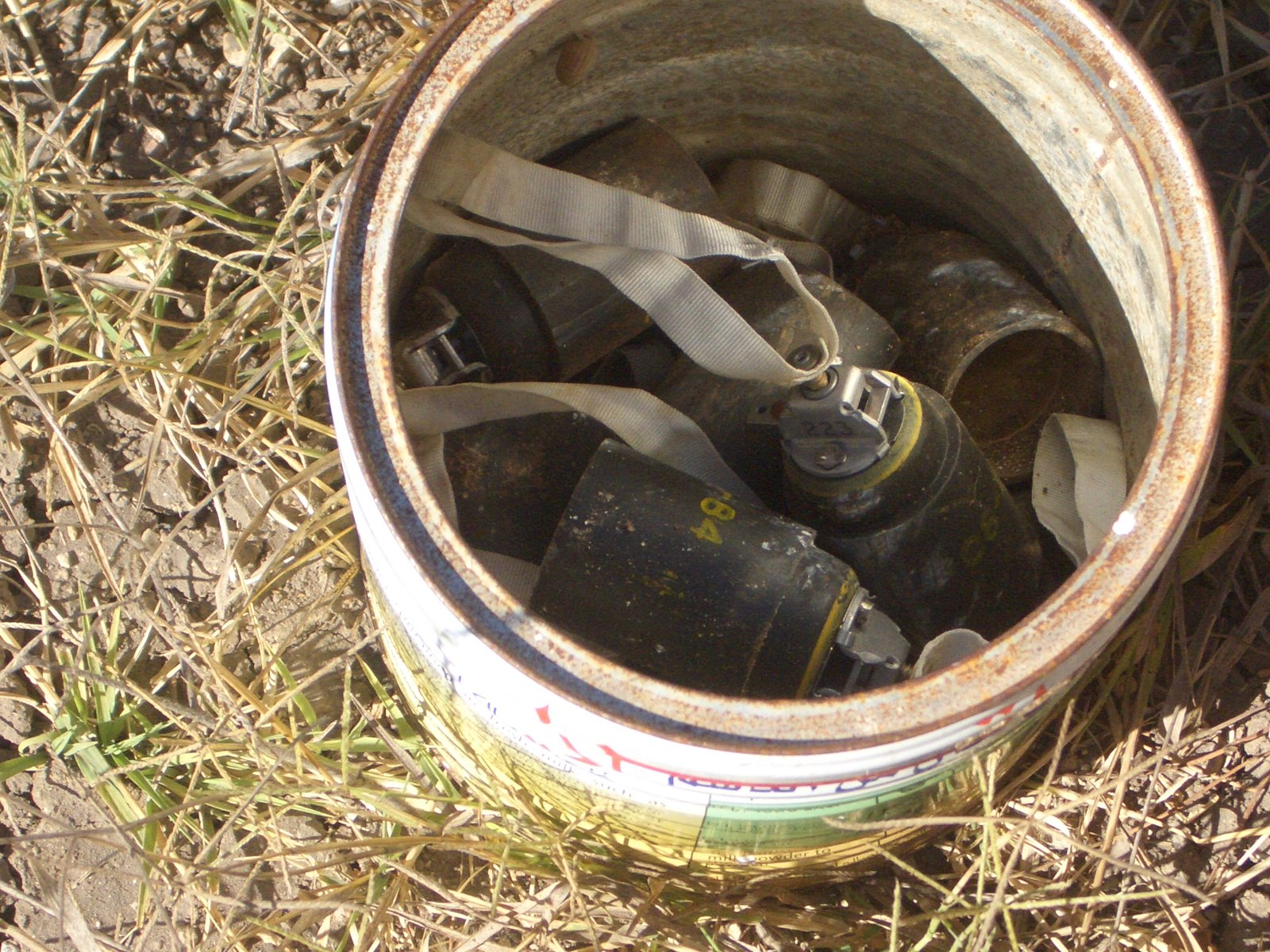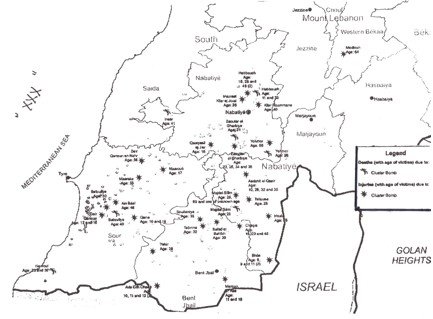

The Middle East
Israel’s Gifts to Lebanon
Israel’s cluster bombs – many American-made – litter the south of Lebanon.
From the Litani River in the North, to Naqoura on the Mediterranean in the South, to Kfar Chouba in the East along a border of mines running parallel to Palestine, Lebanon continues to be one massive mine field.
Landmines and unexploded ordnance (UXO were never removed by the retreating Israeli army in 2000, following 22 years of occupation. Nor did Israel fully keep its pledge to give the United Nations “mine maps” as it left the South. Consequently, live ordnance continues to hamper the restoration of peace and security in the area and prevents reconstruction, social-economic development and the general well being of the people of South Lebanon.
During the period 1978-2000, more than 250 casualties were documented from this hazard. Others were not officially reported for one reason or another. As recently as 2004, approximately 410,000 landmines still had to be found and removed. During July-August 2006 Israel is estimated to have dropped nearly one hundred fifty thousand additional cluster bombs, in more than 700 locations in scores of villages, roughly 85% of them during the last 72 hours leading up the cease fire. One Israeli defense official was quoted as saying that this was Israel’s response to those who criticized Israel for using cluster munitions against the civilian population during the preceding month.
While Israel was dumping its stockpiles of cluster bombs in the run up to the cease fire, it also doubled from roughly 2,500 to nearly 6,000 the daily number of bombs and artillery rounds during the final 72 hours of August 11-14, 2006.
As of September 5, 2006, it is estimated that fewer than 2% of the cluster munitions have been made safe or removed. A danger remains for all those families who live in the South of Lebanon. In addition, UNIFIL personnel, the Lebanese Army, humanitarian workers distributing food, water and supplies as well as travelers through the area are at mortal risk. Vast areas of fertile farmland, including this season’s crop can not be used or harvested. Grapes, pomegranates, black walnuts, sundry varieties of melons, oranges, olives, figs and cranberries, black berries, bananas, lemons, cranberries, cactus fruit (sober), peaches, pears, and garden vegetables can be seen rotting on their vines or trees. It is far too dangerous to attempt harvest. Toward the end of August, 2006 one man was killed as he was trying to harvest apples near the village of Tebnine, unaware of an M-42 cluster munitions, which had snagged onto a branch he was shaking in order to collect his fruit. The Lebanese Department of Agriculture estimates that nearly 75 % of this year’s crop has been lost; totally $400,000.
As of September 5, 2006, the United Nations Mine Action Coordination Center in Tyre, Lebanon has documented 16 killed and 65 wounded from unexploded cluster bomblets. These figures included only those reported from areas with electricity and a means of communication. As of September 5, 2006, nearly 80 percent of the villages in the South were still without electricity or water.
In addition, scores of sheep, goats, cattle, horses and chickens have been killed or injured due to cluster munitions throughout the South. Many animals can not graze and shy away from pastures. Often farm animals are now kept tethered near what’s left of a farm house or shed. According to Major Bapu Parasanalli of the Indian Battalion of UNIFIL, a veterinarian, his unit has treated 145 people and over 1000 animals in a two-week period from Aug 15-September 1, 2006. As of that date, Major Parasanalli’s figures of Cluster Bomb casualties have not been included in the UNMACC statistics.
The United Nations Mine Action Coordination Center, UNIFIL , NGO’s, as well as commercial and NGO De-mining Organizations in Southern Lebanon have confirmed to this researcher the following Anti Personnel (AP) mines found between 1978-2006.
 |
The same organizations have found the following Anti Tank (AT) mines:
 |
In addition to the above noted unexploded ordnance, American Cluster Bombs, which is the primary focus of a study to be released in late September, 2006 are scattered across the South of Lebanon. All six of the CBU’s pictured s are American made and were supplied to Israel at various times between 1973 and 2006. The MK 118 Mod “rockeye” was used widely, including in the densely populated Fakhani Sabra-Shatilla, Burj al-Baragneh, Haret Hriek, and Dahryah neighborhoods of Beirut.
The first major shipment of American cluster bombs to Israel was ordered by President Nixon during the Yom Kippur War in October, 1973 when Israeli PM Golda Meir threatened to use Nuclear weapons to stop Israel being overrun by Arab forces. All of the types pictured below were used by Israel against the civilian population in 1978, 1979, 1981, 1982-2000, and 2006. There are unconfirmed reports that Israel also used in July-August, 2006 an Israeli knock-off version of the American M-42. When this is confirmed it will be documented, photographed and reported.
 |
Case study: Between July 14, 2006 and September 4, 2006, UN and NGO de-mining teams have confirmed 475 CBU strike locations in dozens of villages.
The photos below were taken by an American researcher at the villages of Al Sultanieh, and Zibqin on September 2, 2006, where he counted more than 70 unexploded M-42 cluster bomblets laying in gardens, along the sides of roads, on patios, doorsteps and backyards. With his colleagues, this researcher is committed to examining at least 100 more villages, based on reports by local authorities indicating where American cluster bombs have been sighted.
 |
Young Hussein’s House Restriction
 |
The young man pictured inside his house is named Hussein. He is five years old and he was on “time out” when this photo was taken at 4:30 pm on Thursday August 30, 2006. Hussein had just been reprimanded by his father. The reason for the chastisement was that Hussein had been outside playing in a field behind his house picking up “toys”. The bucket shown below is his proud collection of U.S. M-42 cluster bomblets. Some boys think the M-42’s are “lighters” or “batteries”. Some girls told this observer that they look like “perfume bottles”.
 |
According to the Pentagon (please see Israel’s War in Lebanon, South End Press, 1984) the purpose of the M-42 is to provide anti-material and anti-personnel capabilities in a 155 mm artillery shell (each shell holds 64 bomblets) or an eight-inch howitzer cannon shell. Israel prefers the former and has stockpiled more than 18,000 of them from the United States. Upon impact, inertia weight drives the firing pin of the M-42 into the detonator M-55 and shaped charge jet blasts downward while the body bursts into a large number of fragments. The M-42 is designed to penetrate 2.75 inches of homogenous armourplate.
Hussein had a temper tantrum when his “new toys” were taken away from him and delivered to an explosive expert for destruction, and he howled when his new “toys” were detonated. A fistful of Reese’s peanut butter cups from an American visitor could not console him. Hussein was furious! The villagers and local authorities view it as a miracle that these American weapons did not explode as Hussein gathered them.
In another nearby village four children were injured when they threw a “ball”, the size of a tennis ball, probably a BLU 63 B or a BLU 26 B cluster bomblet, against a cinderblock wall and at first it did not explode. A nine year old survivor reported from his hospital bed that they thought it was a “firework” and they wanted to see it light up.
On July 18 and July 21 two children were killed by a cluster bomb explosion in the town of Naqoura.
On the very morning of the August 14, 2006 ceasefire in Nabatiyeh, 11 year old Hadi Hatab stepped out to play in the street for the first time in more than a month.
Seconds later a cluster bomb exploded. Hearing the blast, Hadi’s father, Moussa Hatab, 32, raced to help his son, detonating another bomb that killed him 72 hours later, according to Dr Ali Haj Ali of the Najde Hospital in Nabatiyeh. Several other members of the family were also wounded by the bombs.
The sketch below offers a preliminary list of deaths and injuries by cluster bombs between August 8, 2006 and September 1, 2006.
Southern Lebanon
Preliminary list of deaths and injuries by cluster bombs after ceasefire
 |
The United Nations believes that this type of lethality will continue as it has for more than a quarter century until Lebanon’s South is cleaned up. One would hope that as Congress rushes to repair the damage done to Northern Israel that help might be offered Lebanon as it tries to clean its country of unexploded American ordnance.
In addition to Cluster Bombs, scores of 500, 1000, 2000, and larger bombs are being found unexploded. This observer has seen 4 Mk-82 Precision Guided Bomb’s – 2000 lb “Bunker Buster” types that did penetrate up to 3 feet of concrete and entered the ground but failed to detonate. The English print, green in color, on the side of one reads: “Wing Extension Guided Bomb 96214-6899-10. For use on Mk-82. Slow speed only:”
Neither the UN, Lebanese Army, or on-site NGO’s has the personnel, knowledge, or equipment to render these large bombs harmless. Were they to detonate, these enormous bombs could destroy much of the village where they rest. Some local authorities are advising villagers to “just fill in the hole for now”.
| Videos & Multimedia |
| More Articles on the Region |
Report: IDF doctor says Dirani rape claim backed by evidence |
| Additional Resources |
| Stay Informed |
|
Sign up for our mailing list and receive an email whenever we post a new article on our news site, Israel-Palestine News. |
If Americans Knew distributes and posts to our website copyrighted material, sometimes without the permission of the copyright owner. We are making such material available in our efforts to advance understanding of the Israel/Palestine conflict. We believe this constitutes a ‘fair use’ of any such copyrighted material as provided for in section 107 of the US Copyright Law since it is being distributed without profit for purely educational purposes. For more information go to: http://www.law.cornell.edu/uscode/17/107.shtml. If you wish to use copyrighted material from this site for purposes of your own that go beyond ‘fair use’, you must obtain permission from the copyright owner.
This website is printer-friendly. Please Print this article and share it with your friends and family.

